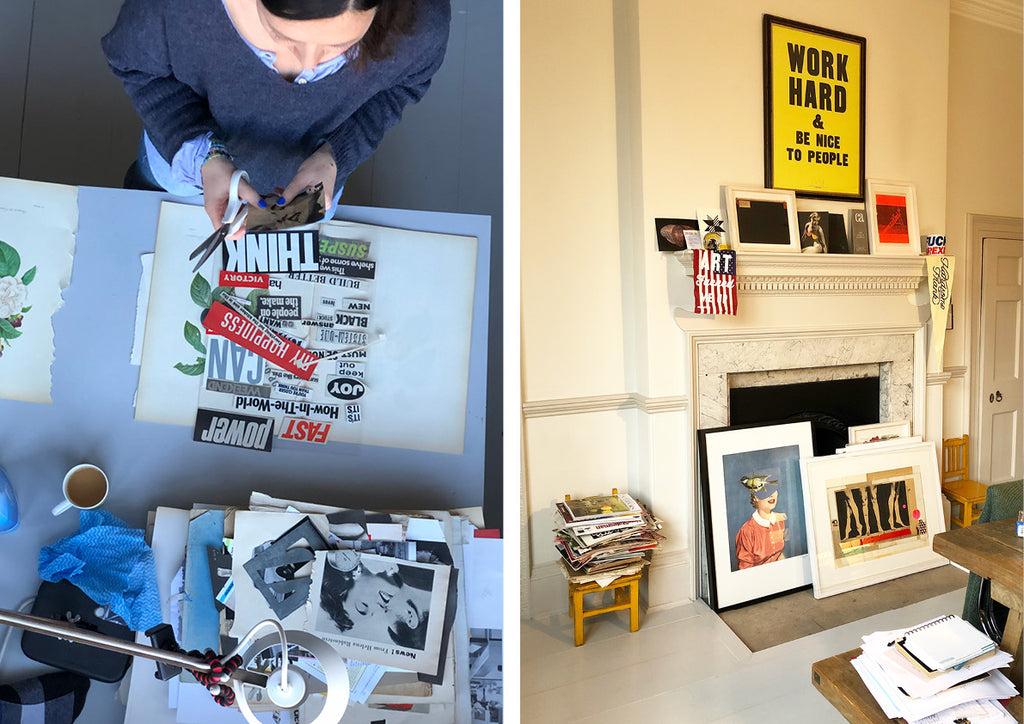
In this series, we chat with inspiring women artists around the world about their life and work and everything in between.
Michelle Thompson has three collages percolating at the moment. “When something isn’t quite right, I put it away in a drawer and the static from a sheet of Perspex stops the pieces from flying around,” she says. Among the present unstucks is a work that centres on a black-and-white photograph of a girl in a pinafore with a keyboard balancing on her knees. A jagged line slices across the image in a rough diagonal, cropping out a second figure who seems to have forgotten his or her shoes. The cut-out girl perches on a poppy-red square, which rises like a rock from a bright blue strip. A small scrap of text resembles a clue.
“I’ve always wanted to make art,” says Thompson, who left school at 16 to study graphic design and from there went on to do a degree in illustration at The Norwich School of Art and a masters at London’s Royal College of Art. Though more of a hobbyist, her grandad was an oil painter with his own studio. When she was a child and her mother said she could have anything she liked from the shops, she would always choose a pencil. “I actually can’t draw,” she admits, laughing, “but when I was at the Royal College, I realised that art doesn’t always have to look like real life.”
Collage, an abstract art form that splices together snippets of pasted materials, reworks reality as we know it. A reaction against imitation, it gained attention in the early 20th century when Pablo Picasso and Georges Braque introduced fragments of paper and cloth into their Cubist compositions in a bid to move beyond the two-dimensionality of painting. In the hands of the Dadaists, it became a tool for social commentary; Hannah Höch and her contemporaries juxtaposed jarring images from mass media in a protest against cultural politics. The Surrealists capitalised on the bizarre and dreamlike potential that came with pairing disjointed components. When Thompson started out, she looked to the German artist Joseph Beuys, as well as Abstract Expressionists Robert Rauschenberg and Robert Motherwell.

There are two strands to Thompson’s work: she produces collages that she sells online, in galleries and at fairs, and illustrations for clients that include The Guardian and The Financial Times. “They meet in the middle and sort of feed each other,” she says, explaining that if a publication isn’t keen on a design, she’ll hold onto it and wind up using it somewhere else. Fittingly, for a technique that’s all about recycling, “Nothing is ever wasted.”
In her home studio, she has 25 years’ worth of vintage magazines in plastic boxes. “Every time I start something new, I’ll get a box and flick through it and keep everything I like to one side,” she says. “Images take on a new relevance depending on what I’m working on.” She lives in Saffron Walden and continues to add to her collection of cast-offs with old postcards and other preloved materials plucked from the town’s many charity shops. “I like the idea of creating a memory using old memories.”
Thompson does her collage work during the day, on a chest of drawers beside a bay window that lets in lots of light. “What I’m most drawn to is paper, what it actually looks and feels like. Often, a work just stems from the fact that I like a certain clipping and want to stick it on another one.” She combines found materials with her own painted, drawn and printed elements, all of which she cuts, layers and glues onto the picture plane. Instead of using a scalpel with a fine blade, she switches between a clunky Stanley knife and a simple pair of kitchen scissors. “I’m not really interested in cutting things out cleanly,” she says, smiling. “I like clumsiness.”

Her work started out very abstract and has become more narrative over time. Illustrative elements such as photographs and adverts reflect contemporary themes and popular culture. “I like being involved in what’s going on around me,” she says. “When something happens, I have to make a piece of work about it.” This natural inclination to see art as a way of making sense of the world fits nicely with her editorial commissions, which are mostly produced on the computer because of the quick turnaround time and illustrate reports on everything from sex and fashion to the environment and global politics.
There’s something quite analytical about collage, which takes existing images and ideas and re-examines them in a newly assigned context. But at the same time, it’s a playful and intuitive technique that relies on sure instinct about what makes or enhances a work. “Sometimes I’ll swing from one thing to the other,” says Thompson. “At other times, I have all the elements and it’s almost like piecing together a jigsaw puzzle.” Colours and textures chime and clash, while pasted components exist both in opposition and together. And sometimes, as with the girl in the pinafore with the keyboard balancing on her knees, “it can all just be created around one picture.”
Interview by Chloë Ashby.
All images courtesy of Michelle Thompson.
Find more of Michelle's collage pieces on her Instagram.
Add a comment